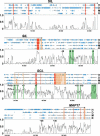Analysis of multiple genomic sequence alignments: a web resource, online tools, and lessons learned from analysis of mammalian SCL loci
- PMID: 14718377
- PMCID: PMC327107
- DOI: 10.1101/gr.1759004
Analysis of multiple genomic sequence alignments: a web resource, online tools, and lessons learned from analysis of mammalian SCL loci
Abstract
Comparative analysis of genomic sequences is becoming a standard technique for studying gene regulation. However, only a limited number of tools are currently available for the analysis of multiple genomic sequences. An extensive data set for the testing and training of such tools is provided by the SCL gene locus. Here we have expanded the data set to eight vertebrate species by sequencing the dog SCL locus and by annotating the dog and rat SCL loci. To provide a resource for the bioinformatics community, all SCL sequences and functional annotations, comprising a collation of the extensive experimental evidence pertaining to SCL regulation, have been made available via a Web server. A Web interface to new tools specifically designed for the display and analysis of multiple sequence alignments was also implemented. The unique SCL data set and new sequence comparison tools allowed us to perform a rigorous examination of the true benefits of multiple sequence comparisons. We demonstrate that multiple sequence alignments are, overall, superior to pairwise alignments for identification of mammalian regulatory regions. In the search for individual transcription factor binding sites, multiple alignments markedly increase the signal-to-noise ratio compared to pairwise alignments.
Figures

References
-
- Altschul, S.F., Gish, W., Miller, W., Myers, E.W., and Lipman, D.J. 1990. Basic local alignment search tool. J. Mol. Biol. 215: 403-410. - PubMed
-
- Begley, C.G. and Green, A.R. 1999. The SCL gene: From case report to critical hematopoietic regulator. Blood 93: 2760-2770. - PubMed
-
- Boffelli, D., McAuliffe, J., Ovcharenko, D., Lewis, K.D., Ovcharenko, I., Pachter, L., and Rubin, E.M. 2003. Phylogenetic shadowing of primate sequences to find functional regions of the human genome. Science 299: 1391-1394. - PubMed
WEB SITE REFERENCES
-
- http://bio.cse.psu.edu/pipmaker; PipMaker home page.
-
- http://lagan.stanford.edu; LAGAN home page.
-
- http://pipeline.lbl.gov/rat/; Berkeley Genome Pipeline.
-
- http://repeatmasker.genome.washington.edu/cgi-bin/RepeatMasker; RepeatMasker server.
-
- http://www-gsd.lbl.gov/vista/; Vista home page.
Publication types
MeSH terms
Substances
Associated data
- Actions
Grants and funding
LinkOut - more resources
Full Text Sources
Medical
Research Materials
Miscellaneous
